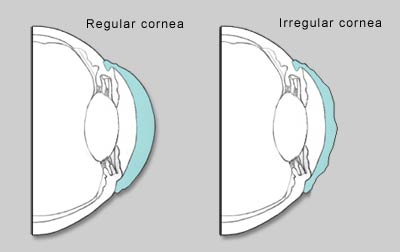 |
| An astigmatic cornea is irregularly shaped,
causing blurred or distorted vision. |
Overview
Astigmatism (uh-STIG-muh-tizz-um) is an uneven or
irregular curvature of the cornea or lens, causing
blurred or distorted vision – such as letters or shapes
appearing to be compressed, stretched, or tilted. It is
treated with corrective lenses or surgery.
Most commonly, astigmatism occurs because the cornea
is oval or egg-shaped instead of round. Along with an
irregularly shaped lens, this causes, light rays
entering the astigmatic eye scatter instead of focusing
to a single focal point on the retina -- some rays fall
on the retina while others focus in front of or behind
it.
Most people have some degree of astigmatism, which is
usually present at birth and is believed to be
hereditary. It can also result from injury or conditions
such as keratoconus or chalazion.
Astigmatism tends to occur with other refractive
disorders; for instance, about half of those with myopia
(nearsightedness) are also astigmatic.
Symptoms
The most common symptom is blurred vision in both near
and distant vision. Those with mild cases may have
blurred vision only at certain distances, or see fine
but experience headaches or eye strain (from squinting).
If you have astigmatism, you may see better in some
directions than others (vertically, horizontally or
diagonally) or recognize some letters or shapes more
easily than others (O versus X).
Although we are usually born with astigmatism, it is
often not diagnosed until a child begins to read. Other
symptoms can include:
- The need to squint
- Headaches
- Eyestrain
- Eye fatigue
Prevention
Astigmatism cannot be prevented. However, your degree of
astigmatism can increase with age, and regular eye exams
can determine the need for increased strength of
corrective lenses. If your astigmatism seems to be
rapidly growing worse, you may be experiencing the onset
of a more serious eye disease such as keratoconus or in
which the center of the cornea thins and develops a
cone-shaped bulge that blurs and distorts vision.
Parents and those who work with children should be
aware that astigmatism could contribute to poor
performance in school. Routine eye tests conducted in
schools may not detect astigmatism, so regular exams by
a qualified eye doctor are recommended.
Treatment
Since most people have some degree of astigmatism, it is
considered normal. If minor, treatment may not be
required but is certainly beneficial. Moderate or severe
astigmatism can be treated with a variety of methods:
Corrective Eyewear
- Eyeglasses. If you already wear glasses for
another refractive error (such as
nearsightedness), correction for your
astigmatism may be included in your
prescription.
- Contact lenses are another option. Toric
contacts are specifically designed for people
with astigmatism; they compensate for an
irregularly shaped lens or cornea by having
different powers of correction at different
points on the lens. And rigid gas-permeable
contact lenses may actually help prevent
astigmatism from progressing.
Laser Surgery may benefit some astigmats
with irregularly shaped corneas. LASIK (laser
in-situ keratomileusis) is a procedure in which a
surgeon slices a flap into the cornea and a laser
removes some tissue from beneath the sliced area to
reshape the cornea. But corrective lenses may still
be required following the surgery for certain
activities.
|